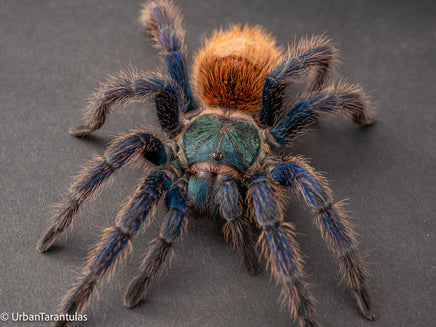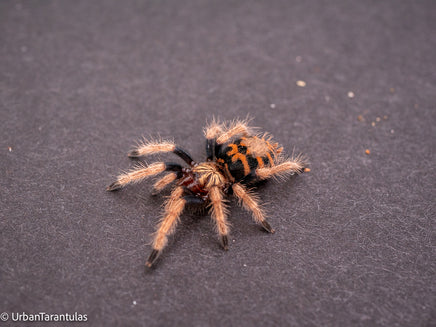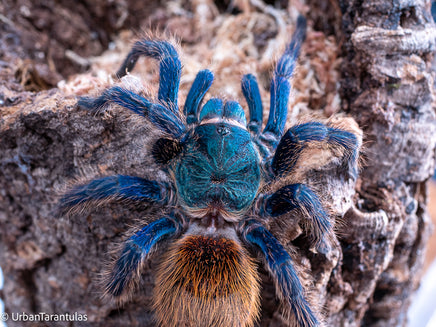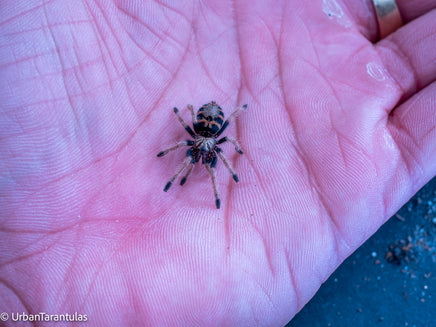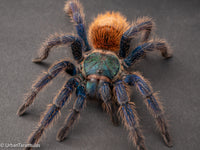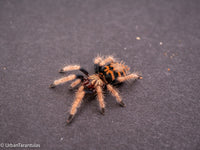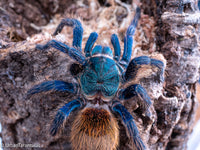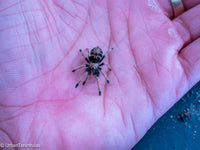Chromatopelma cyaneopubescens – Green Bottle Blue Tarantula
Bright, bold, and constantly moving—Chromatopelma cyaneopubescens, or the Green Bottle Blue, is a crowd favorite for a reason. Metallic blue legs, a shimmering green carapace, and fiery orange abdomen hairs make it one of the most eye-catching tarantulas in the hobby. It's a heavy webber too, creating thick silk tunnels and hammocks in even the simplest enclosures. Active and easy to care for, this species is ideal for beginners and long-time keepers alike who want something vibrant and entertaining.
🕸 Care Details:
-
Temperature: Keep between 75–85°F (24–29°C). Warmer temperatures speed up growth and molting, which makes husbandry more flexible.
-
Humidity: Aim for about 55%, but don’t overthink it. Coming from dry scrublands, this species prefers low humidity. Just keep the substrate slightly dry, not dusty.
-
Housing – Terrestrial Setup:
-
Babies: I recommend a 1 oz to 4 oz deli container with needle-pierced ventilation. Ask at checkout if you'd like me to include a free one—but if you don't ask, I won't include it.
-
Juveniles: Use a container 2 to 3 times the tarantula’s leg span.
-
Adults: A terrestrial enclosure with 4–6 inches of dry substrate, good cross-ventilation, and anchor points for webbing. They don’t burrow but will cover everything in silk.
-
🪳 Diet Info:
I feed mine a rotating menu of crickets, red-runner roaches, Dubia, lobster, and even Madagascar hissing roaches.
For babies, tiny roaches or pinhead crickets work great.
If feeders are too large, crush the head and leave it in—the tarantula will scavenge.
Remove uneaten prey to prevent mold or stress.
As an occasional treat, pinky mice or small lizards are okay—but don’t overdo it. Too much calcium can lead to impaction, and your tarantula may struggle to poop.
🔍 In-Depth Facts:
-
Latin name: Chromatopelma cyaneopubescens
-
Common names: Green Bottle Blue, GBB
-
Locale: Paraguana Peninsula, Falcón State, Venezuela
-
Category: Terrestrial, heavy webber, surface dweller—not a burrower
-
Size: Females reach up to 7”, males slightly smaller
-
Urticating hairs: Yes—but not quick to kick; prefers to bolt or hide if threatened
-
Growth rate: Fast. You'll see rapid development, especially with frequent feeding and warm temps
-
Life span: Females can live 12–15 years; males around 3–4 years
-
Recommended for: Everyone. Perfect for first-time keepers, collectors, and anyone who enjoys high activity and color in a tarantula
📲 Stay Connected:
-
Instagram – I’m most active here
-
YouTube – Care guides, unboxings, and species spotlights
-
Facebook – Honest customer reviews
-
TikTok – Fun, educational clips and feeding videos
⚠️ Safety Disclaimer:
Experiencing a tarantula bite is an extremely rare occurrence, and it's important to note that there have been no recorded fatalities due to a tarantula bite. The venom potency varies across species, with Old World tarantulas generally having stronger venom than their New World counterparts. Within the Old World category, the Poecilotheria genus is known for having particularly potent venom.
It's crucial to approach tarantulas with respect and understanding. If you happen to get bitten, which is unlikely, the key is to stay calm. In most cases, the discomfort is superficial and subsides within a few minutes to a few hours. However, bites from species with more potent venom may result in symptoms lasting up to a week. Remember, larger tarantulas tend to have more venom than smaller ones.
Please be aware that I cannot assume responsibility for bites. Tarantula handling should be done at your own risk. In my 11 years of experience with these creatures, I have only been bitten once, by a species with highly potent venom. While the experience was painful, the symptoms had completely disappeared after a week.
Handle tarantulas responsibly, and always prioritize your safety and the well-being of the tarantula.
